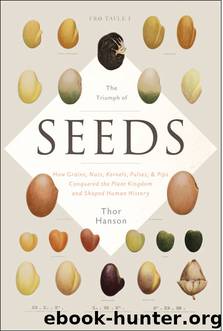The Triumph of Seeds: How Grains, Nuts, Kernels, Pulses, and Pips Conquered the Plant Kingdom and Shaped Human History by Thor Hanson

Author:Thor Hanson [Hanson, Thor]
Language: eng
Format: epub, mobi, azw
ISBN: 9780465048724
Publisher: Basic Books
Published: 2015-03-23T22:00:00+00:00
FIGURE 9.2.Chili pepper (Capsicum sp.). The thousands of varieties of domestic chili peppers descend from four species native to South America. In the wild, their pungency repels seed-killing fungi as well as rodents and other mammals that can’t take the heat. ILLUSTRATION © 2014 BY SUZANNE OLIVE.
“I’m basically a mycologist,” she said, and explained how the prolific toadstools of the rainy Pacific Northwest had helped draw her from her home near Chicago. She studied them on the forested campus of Washington’s Evergreen State College, and then entered graduate school to pursue a particular passion. “I’m fascinated by how fungi interact with plants,” she told me—how they exchange nutrients with roots in the soil and show up everywhere from bark to flowers to the insides of leaves. So when biology professor Joshua Tewksbury asked her to help identify a fungus growing on wild chili-pepper seeds, she was all ears. At the time, Tewksbury had already followed his research on chilies from the American Southwest to the Chaco region of Bolivia, where he’d discovered a species that varied in pungency from completely mild in dry habitats to what Noelle described as “definitely hotter than Tabasco” in wet ones. Intermediate places had the two forms growing side by side, and the only way to tell the difference was to taste them—sometimes hundreds in a day. Luckily for Tewksbury, he’d found the ideal collaborator: a mycologist who liked spicy foods. “I do tolerate chilies better than the average person,” she allowed. But when I pressed the question, she laughed, and confessed to keeping a bottle of hot sauce in her desk drawer at work. “Josh does too!” she added.
The Bolivian chilies presented a rare opportunity. They seemed to preserve that key moment in time when pungency was just evolving. “We know the first chilies weren’t hot,” Noelle said firmly, and explained that all modern species, no matter how spicy, descended from a mild common ancestor. Whatever ecological dilemma caused that distinctive hotness to evolve appeared to be ongoing in Bolivia, where some chilies had made the switch and some hadn’t. If Noelle and the rest of the team could figure out what was going on, they would indeed know how, and why, the chili got its spice. Chemically, the answer was already in the bag.
Scientists long ago traced the pungency in chilies to the presence of capsaicin, a compound produced in the white, spongy tissue that surrounds the seeds. It’s what experts call an alkaloid, a type of chemical that may be more familiar than you think. Alkaloids all share a similar nitrogen-based structure, a set of building blocks that plants have arranged and rearranged into more than 20,000 distinct combinations. The nitrogen matters because it’s a vital nutrient that plants also need for growth, so they don’t use it on alkaloids without a purpose. Usually, that purpose amounts to some form of chemical defense. And because plants usually need to defend themselves against animals, alkaloids almost always have an effect on people, too. They can be spicy, like capsaicin, but that’s just the beginning.
Download
The Triumph of Seeds: How Grains, Nuts, Kernels, Pulses, and Pips Conquered the Plant Kingdom and Shaped Human History by Thor Hanson.mobi
The Triumph of Seeds: How Grains, Nuts, Kernels, Pulses, and Pips Conquered the Plant Kingdom and Shaped Human History by Thor Hanson.azw
This site does not store any files on its server. We only index and link to content provided by other sites. Please contact the content providers to delete copyright contents if any and email us, we'll remove relevant links or contents immediately.
| Cacti & Succulents | Flowers |
| Mushrooms | Trees |
Sapiens: A Brief History of Humankind by Yuval Noah Harari(14251)
The Tidewater Tales by John Barth(12608)
Mastermind: How to Think Like Sherlock Holmes by Maria Konnikova(7227)
Do No Harm Stories of Life, Death and Brain Surgery by Henry Marsh(6890)
The Thirst by Nesbo Jo(6826)
Why We Sleep: Unlocking the Power of Sleep and Dreams by Matthew Walker(6618)
Life 3.0: Being Human in the Age of Artificial Intelligence by Tegmark Max(5474)
Sapiens by Yuval Noah Harari(5294)
The Longevity Diet by Valter Longo(5019)
The Body: A Guide for Occupants by Bill Bryson(4974)
The Rules Do Not Apply by Ariel Levy(4861)
The Immortal Life of Henrietta Lacks by Rebecca Skloot(4525)
Animal Frequency by Melissa Alvarez(4395)
Why We Sleep by Matthew Walker(4360)
The Hacking of the American Mind by Robert H. Lustig(4318)
Yoga Anatomy by Kaminoff Leslie(4305)
All Creatures Great and Small by James Herriot(4232)
Double Down (Diary of a Wimpy Kid Book 11) by Jeff Kinney(4207)
Barron's AP Biology by Goldberg M.S. Deborah T(4097)
